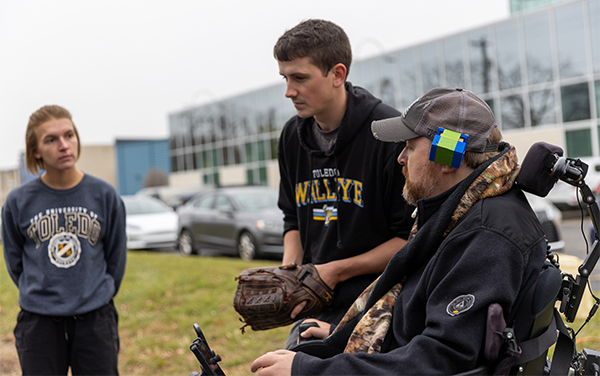As their senior projects, two teams of engineering students at The University of Toledo worked together to design a baseball launcher and catcher so that a quadriplegic man can play catch with his young nieces and nephews.
The graduating seniors used their creativity and problem-solving skills to help Jeremy Bigelow from Sylvania live as independent a life as possible.

From left, Abigail Schroeder and Kevin Hamburg, both mechanical engineering students who graduate Dec. 17, worked with their team to help Jeremy Bigelow, a paralyzed man from Sylvania, be a more playful uncle. They’ll present their baseball launcher and catcher alongside more than 60 other team projects as part of Friday’s College of Engineering Senior Design Expo.
Bigelow is paralyzed from the shoulders down after he injured his spinal cord in a car crash 12 years ago.
The students will present their final prototype alongside more than 60 other team projects as part of the College of Engineering’s Senior Design Expo from noon to 3 p.m. Friday, Dec. 9, on the first floor of Nitschke Hall.
“Our work is adding to the number of activities Jeremy is successfully taking on in the face of his adversity,” said Keenan Marter, a UToledo student who is graduating on Dec. 17 with a bachelor’s degree in mechanical engineering. “Knowing that our project will be assisting in Jeremy’s dream to safely interact with young members of his family on a new level is fulfilling and rewarding.”
More than 200 students worked with local businesses, industries and federal agencies to help solve technical and business challenges, with projects ranging from a CPR machine and a vein finder to a system that can sort invasive fish species out of an ecosystem.
Seniors will present their final prototypes, provide hands-on demonstrations and answer questions about their experiences at the expo.
A former baseball, hockey and football player and marathon runner, Bigelow was paralyzed in a car accident in October 2010.
Now a board member with the Ability Center of Greater Toledo and an artist who uses the wheels of his motorized wheelchair to paint, he connected with the UToledo College of Engineering and tasked students to develop a device that helps him play catch with children in his family.
“I grew up playing baseball,” Bigelow said. “All of my nephews are getting older and playing baseball now. And not being able to play catch with them, it’s kind of a bummer. So I was like there’s got to be a way that I can help them practice and play.”
The students created a device that looks like a batting cage and uses Bluetooth technology.
“He doesn’t need to touch anything,” said Abigail Schroeder, a mechanical engineering student who is graduating with a bachelor’s degree this month. “Since he’s paralyzed from the neck down, we had to get creative with our control system for the device.”
“We made a baseball catcher and launcher,” Marter said. “Jeremy can only move his head and neck, so it uses a tilt sensor that has an input. He will tilt his head and that is going to send an input to our indexer that drops the baseball into a pitching machine and launches a pop fly for his nieces and nephews. And then they can throw the ball into the big net and it’ll funnel it right back down so they can keep playing catch.”
A few days ahead of their final presentation, the teams met with Bigelow and his 10-year-old nephew Joshua outside North Engineering to test the prototype and learn what adjustments needed to be made before the Senior Design Expo at the end of the week.
“It turned out great,” Bigelow said. “The concept is there. We practiced with Josh. And it all is functional, and it works. It’s an awesome way to be able to interact and be that uncle, that playful uncle that’s out there. I may not be out there running around and throwing a ball, but I can do things still, they’re just different than how you grew up doing them.”
“It’s crazy that this will make Uncle Jay able to play with us — play with me and my brother and sister,” said Bigelow’s nephew Joshua, a third grader.
“It’s so incredible because normally you do a college class, and you get a grade out of it,” Schroeder said. “This is something totally different. At the end of the semester, we have something to show for it. And we have something to give Jeremy — a gift that took 10 students a whole semester to make this happen and we’re all so proud of it.”
Visit the College of Engineering website for information about all of the teams, projects and sponsors.